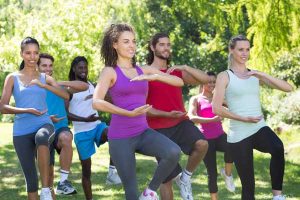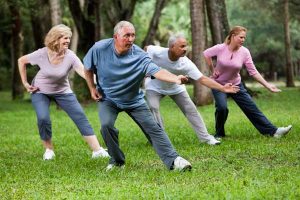We are a Union of many recognised styles of Tai Chi and the other Internal Arts – Baguazhang, Xing Yi Chuan and Qigong.
But what do we mean by “Tai Chi and Internal Arts” and how can they help you?
Tai Chi, Baguazhang, Xing Yi Chuan are the main “martial” arts but many teachers focus on the health aspects and the associated forms. In contrast, the term “Qigong” encompasses many hundreds of different types of exercises which are taught for health benefits.
Below we give a brief introduction to the main arts taught by our instructors including links to our booklets which include more information and the fascinating history.
We also have a list of books and DVDs, written by our members which offer a broad range of information .
Whilst there are many benefits to regular practice, emerging studies have shown that it can help people to reduce stress, improve posture, balance and general mobility, and increase muscle strength in the legs.
Tai Chi
Tai Chi, also called Tai Chi Chuan (Tai Ji Quan), is a martial art and fitness regime using the principles of Yin and Yang to develop a healthy body and tranquil mind. It is a highly effective form of self-defence which is now more often taught with an emphasis on the hand forms which combine deep breathing and relaxation with co-ordinated, flowing movements. There are weapons forms including sabre, sword and spear. Tai Chi Chuan can be translated as “supreme ultimate fist” referring to the Yin and Yang concepts in this martial art.
Find a Tai Chi Instructor near you
Baguazhang
Baguazhang’s characteristic method of stance and movement training is circle walking, or “turning the circle”. Practitioners walk around the edge of the circle in various low stances, facing the center, and periodically change direction as they execute forms. Students first learn flexibility and proper body alignment through the basic exercises, then move on to more complex forms. Baguazhang literally means “eight trigram palm”, referring to the bagua “trigrams” of the I Ching (Yijing), one of the canons of Taoism.
Find a Baguazhang Instructor near you
Xing Yi Chuan
Xing Yi is characterized by aggressive, seemingly linear movements and explosive power that’s most often applied from a short range. A practitioner of Xing Yi uses coordinated movements to generate bursts of power intended to overwhelm the opponent, simultaneously attacking and defending. Methods vary but always include bare-handed fighting training and the training of weapons. The name of the art translates approximately to “Form-Intention Fist”, or “Shape-Will Fist”.
Find a Xing Yi Chuan Instructor near you
Qigong (Chi Kung)
Qigong practice typically involves coordinating slow-flowing movement, deep rhythmic breathing, and a calm meditative state of mind. People practice for recreation, exercise and relaxation. There are hundreds of Qigong practices. Some exercises are “dynamic” and involve moving around, others are “passive” with little or no body movement. Qigong is composed of two words: “Qi” (air, gas; spirit; atmosphere) and “Gong” (achievement; result; skill). The two words are combined to describe systems to cultivate and balance life energy, especially for health and wellbeing.




